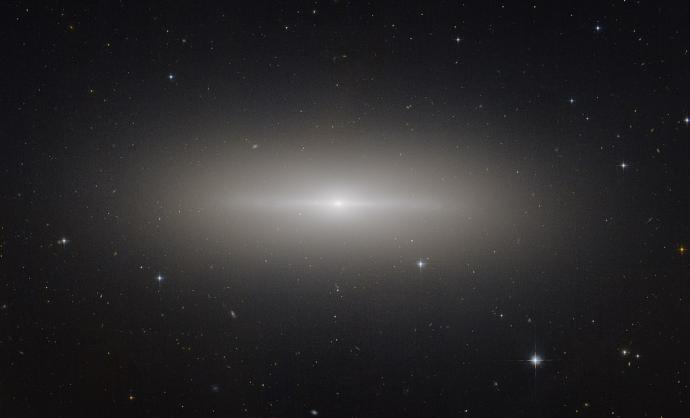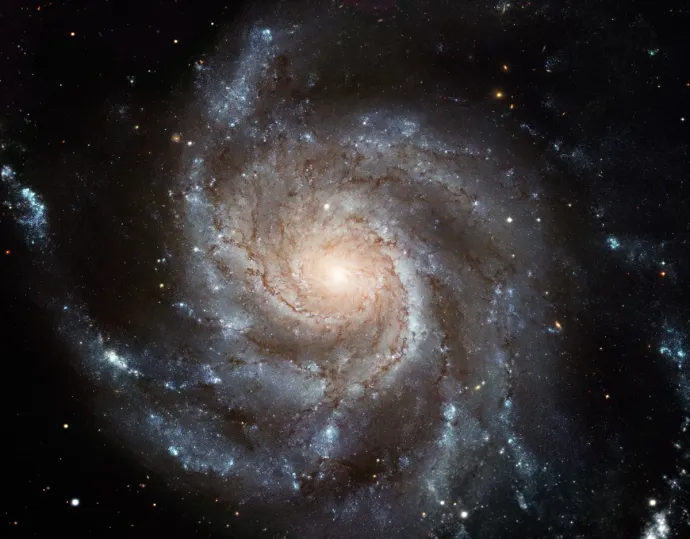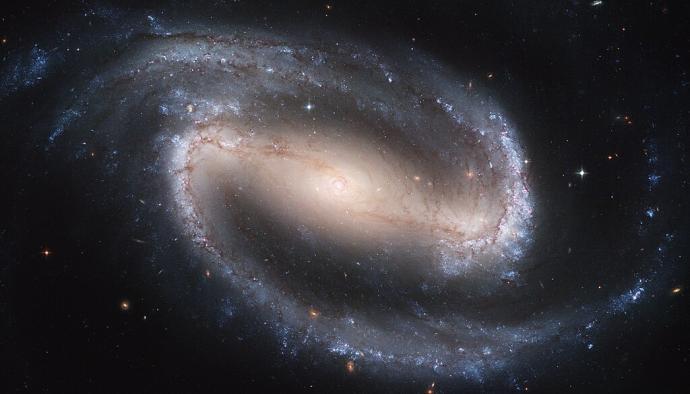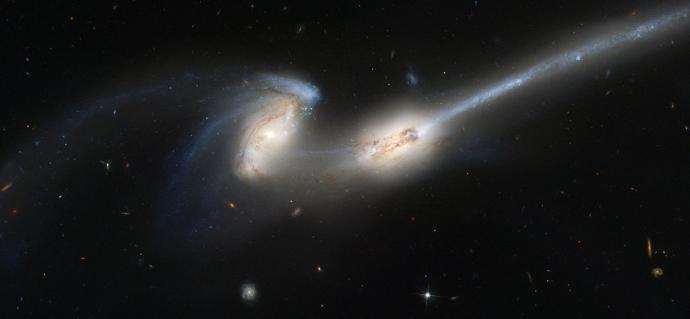By looking at galaxies closely you can start to see similar features.
Sorting schemes have been created to separate galaxies into groups based on how they look. The most famous of these was made by Edwin Hubble in 1936. It is often known as the Hubble tuning-fork because of the shape of it.
There are 3 broad classes of galaxies based on how they look:
- Elliptical
- Lenticular
- Spiral

Since this scheme was made, galaxies have been studied in much more detail. These broad classes have grown to allow for more detail.
Other types of galaxies have also been discovered. There are now irregular galaxies, with no obvious structure at all, and dwarf galaxies. Dwarf galaxies have only a few million stars and can be spiral, elliptical, or irregular in shape.
- Elliptical Galaxies
Elliptical galaxies are round collections of old stars. They contain very little gas and dust and have no features within them. They come in a range of different sizes and shapes. They can look circular, oval or even rugby-ball shaped.
Image CreditThis work by ESA/Hubble/NASA is licensed under Creative Commons Zero v1.0 Universal
CreditThis work by ESA/Hubble/NASA is licensed under Creative Commons Zero v1.0 UniversalElliptical galaxy - IC 2006 Ellipticals are given the letter E. They are also given a number based on how squashed they seem. If they look like balls (circular), they are classified as E0. The more squashed they look, the higher the number they are given. This makes them appear more like rugby balls. The most flattened ellipticals are classed as E7.
The smallest ellipticals are called dwarf ellipticals. They contain tens of millions of stars. The largest ones can contain over a trillion (1,000,000,000,000)! Some ellipticals can be very dim, and some very bright. This is mainly down to how many stars they contain.
Elliptical galaxies are very old. They formed their stars a long time ago. With the gas and dust long since gone, no material is left to make new stars. Without any young, blue stars, ellipticals look yellow-red in colour. They are the most common type of galaxy found in clusters.
- Lenticular Galaxies
These are given the tag S0. They have a bright central bulge surrounded by a disk structure. Unlike spiral galaxies, the disks of lenticulars have no visible spiral shape.
It does not appear that stars are still forming in these galaxies.
Image CreditThis work by NASA/ESA/J. Erwin (University of Alabama) is licensed under Creative Commons Attribution 4.0 International
CreditThis work by NASA/ESA/J. Erwin (University of Alabama) is licensed under Creative Commons Attribution 4.0 InternationalLenticular galaxy - Caldwell 53 (NGC 3115) - Spiral Galaxies
Spiral galaxies are flat disks of stars, gas and dust. The disk rotates around a bulge of much older stars. Around the main disk is a much fainter halo of stars. Most of these halo stars live in globular clusters. Up to 65% of the galaxies we can see are spirals.
Spirals are named after the spiral structures (or arms) that come out from the central bulge into the disk. These arms are often lumpy. They are the site of new stars being born. The areas where stars are forming are brighter than the surrounding disk. This is because of the young, hot, blue stars which live within them.
Image CreditThis work by NASA/HST is licensed under Creative Commons Zero v1.0 Universal
CreditThis work by NASA/HST is licensed under Creative Commons Zero v1.0 UniversalSpiral galaxy - M101 Because these galaxies still have lots of gas and dust, they are thought to be quite young compared to elliptical galaxies. Many astronomers believe that, over time, spirals will evolve into ellipticals.
Spiral galaxies are mostly found in low-density regions of the Universe (i.e. with few other galaxies nearby). It is rare to see them in the middle of galaxy clusters. Our own galaxy, the Milky Way, is thought to be a spiral galaxy with a central bar.
Standard spiral galaxies are given the symbol S. At least half of spirals seem to have a bar structure in the middle, and these are given the symbol SB.
Spirals are given another letter based on how tight the spiral arms are and how big the central bulge is. Sa (and SBa) galaxy types have tightly wound arms and large central bulges. Sc's (SBc's) have loosely wound arms and a small central bulge. Sb and SBb's lie somewhere in the middle.
- Barred Spiral Galaxies
A barred spiral galaxy is a spiral galaxy with a central bar-shaped structure made of stars.
Bars are found in up to 65% of spiral galaxies. They affect the motions of stars, dust and gas. Bars act a bit like a funnel, pulling matter into the bulge from the disk. This leads to stars forming in bursts within the centre.
Image CreditThis work by NASA/ESA/The Hubble Heritage Team (STScI/AURA) is licensed under Creative Commons Zero v1.0 Universal
CreditThis work by NASA/ESA/The Hubble Heritage Team (STScI/AURA) is licensed under Creative Commons Zero v1.0 UniversalBarred spiral galaxy - NGC 1300 Astronomers can look at samples of galaxies from different points in time. The further back we go, the fewer barred spirals we see. This might suggest that the bars form as the galaxies grow older. It is also thought that this is only a phase in a spiral galaxies life and that the bars will someday fade. This might leave behind a large core at the centre of the galaxy with a smaller disk. This could be a possible transition from a spiral to an elliptical galaxy.
It isn't easy to see the true shape of our own galaxy, the Milky Way. Astronomers have suggested that we live in a barred spiral galaxy by measuring the movement of stars in the night sky.
- Irregular Galaxies
An irregular galaxy does not have an obvious shape like spirals or ellipticals. They do not fall into any of the broad classes of the Hubble tuning fork.
Irregulars often look like a mess. They show no trace of spiral structure or a central bulge. This can often be the result of a recent interaction with nearby galaxies.
Image CreditThis work by NASA/ESA/The Hubble Heritage Team (STScI/AURA) is licensed under Creative Commons Zero v1.0 Universal
CreditThis work by NASA/ESA/The Hubble Heritage Team (STScI/AURA) is licensed under Creative Commons Zero v1.0 UniversalIrregular galaxy - NGC 1427A These systems are also called peculiar. They make up around 25% of all known galaxies. In general these systems have lots of gas and dust in them. This means that they can be home to a lot of new stars being born.
The closest galaxy to the Milky Way is an irregular galaxy called the Canis Major Dwarf. It has only 1 billion stars. It is thought to be falling towards the Milky Way, and may one day become part of our spiral arms.
- Interacting Galaxies
Galaxies do not stay still in space. They are always moving. When they come close to each other, they are attracted by gravity. Galaxies are said to be interacting when they are close enough for gravity to start changing their shape.
Image CreditThis work by NASA/ACS Science & Engineering Team/ESA/STSci is licensed under Creative Commons Zero v1.0 Universal
CreditThis work by NASA/ACS Science & Engineering Team/ESA/STSci is licensed under Creative Commons Zero v1.0 UniversalInteracting galaxy - NGC 4676 These interactions can be small, or minor, like when a dwarf galaxy pulls on the spiral arms of a larger neighbour. They can also be large, or major, where 2 huge galaxies crash straight into each other.
Galaxy interactions are common. But most of a galaxy is made of empty space. There are huge distances between the stars in a galaxy. So, during these collisions, it's very rare for stars to crash into each other. Instead, the galaxies can start to warp each others shape or even pass right through one another.
Major interactions can lead to the galaxies merging to become one huge system. It can take millions of years for this to happen, from the first time they pass each other until they settle down to form one large galaxy.
